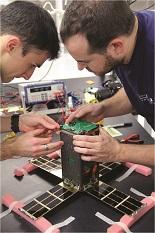

Malphrus is director of the Space Science Center at Morehead State University in eastern Kentucky. He and his team are helping turn science fiction into fact as they design an entire new generation of micro and nano-satellites. And they’re not just designing satellites; they’re also building them — every part — on campus. More than half the construction work is done by undergrads.
Malphrus and his team have ambitious plans for these satellites. In fact, they hope to launch some of them to the moon to scan its dark side for water. “We know there’s water there,” he said. “Where it is and how did it get there? We don’t really know.”
These satellites aren’t your typical behemoths floating through our solar system. They can be as tiny as microwave ovens or as large as dishwashers. So far, Morehead State has launched five satellites with hopes of many more. That’s the point: the satellites work best when a few dozen function as a team. Then they can form various constellations and get to any spot in the planet in 10 minutes.
“These small sats have a gazillion applications,” Malphrus said. “They can respond to radio frequency identification, or RFID, signals. This allows them to fly over warehouses and scan the inventory from outer space. Another potential application would see the satellites scanning entire fleets of seagoing ships so shipping firms know exactly where everything is.”
“The smallest satellites, called cube satellites, can also take images of things like natural disasters, refreshing every 15 minutes, where Google refreshes every 18 months,” he added.
All this work is done at Morehead’s state-funded $16 million Space Science Center building, which is helping the state become known as a widely recognized magnet for aerospace innovation. In fact, Morehead State has gained so much recognition, it was successful in luring away the creator of the cube satellite from Stanford University.
“We’re pretty well internationally recognized,” Malphrus said. “Kentucky is becoming an aerospace hub.”

In a state that’s known for its bourbon and horses, many are surprised to learn Kentucky’s largest export industry is aerospace. Last year, the Commonwealth exported more than $5.6 billion in cutting-edge aerospace products and parts — more than 20 percent of the state’s total exports. Pumping billions of dollars into Kentucky’s economy and providing thousands of jobs, the aerospace/aviation footprint is expanding in almost every sector, from parts manufacturing to supply, from air freight service to education and workforce development.
Plenty of factors contribute to the intense interest in Kentucky, including an excellent infrastructure and location. At the center of a 34-state distribution area in the eastern U.S., Kentucky’s location advantage facilitates the distribution of goods and materials to a massive industrial and consumer market. Kentucky’s borders are within 600 miles of more 65 percent of the nation’s population, personal income and manufacturing establishments.
Kentucky’s airports play a significant role in the industry’s rapid growth. The state’s airport system consists of five commercial airports and dozens of regional airports. The Commonwealth is also home to two of the world’s largest cargo hubs — UPS, in Louisville, and DHL, in northern Kentucky. The Cincinnati/Northern Kentucky region is among the top ranked areas nationally for aerospace products and parts manufacturing, thanks in part to its proximity to the Cincinnati/Northern Kentucky International Airport (CVG).
Nearly two dozen aerospace parts manufacturers and suppliers have expanded Kentucky operations in the past two years. Messier-Bugatti, a global leader in aircraft landing and carbon braking systems, opened a $50 million expansion at its Walton, Kentucky, facility producing wheels and carbon brakes systems. The company added an additional 40 percent of space to the existing plant footprint, adding capacity to accommodate production and refurbishment of carbon brake disks for commercial and military aircraft.
According to Michelle Lyle, a Messier-Bugatti spokesperson, the growth of carbon brake-equipped fleets of aircraft necessitated the Kentucky expansion, which was selected due to its location, proximity to CVG, the technical skills of employees, favorable and stable energy supply and costs, and state and local incentives. “All new aircraft produced are equipped with carbon brakes, so our business grows as airlines acquire new aircraft, particularly when they replace older steel brake aircraft with newer carbon brake aircraft,” she said.
While many high-profile aerospace companies are locating in Northern Kentucky, the industry is touching all parts of the Commonwealth. In Simpson County — in the western part of the state — Vermont Cage recently invested $2 million to expand a facility to produce threaded gage products. In Georgetown, Kentucky, Aichi Forge USA Inc. is investing $5.5 million to expand its aircraft engine forging operation.
None of these moves would have happened without a skilled workforce and specialized training available for companies looking to locate. Fortunately, Kentucky’s education system has embraced the aerospace industry and has a stellar reputation in aerospace/aviation workforce development.

Even high school students are joining the aerospace ranks. The Institute of Aerospace Education (IAE) is a nonprofit devoted to improving student success in the vital science, technology, engineering and mathematics (STEM) and fostering the growth of aerospace careers in Kentucky. The organization interacts directly with students in 23 high schools, providing hands-on experiences by partnering with state agencies, educational institutions and corporations.
The Aviation Museum of Kentucky (AMK) offers academic assistance to educators, providing a “Learning through Aviation” program that incorporates aviation studies into the curriculum, demonstrating the relevance of STEM subjects to aerospace and aviation careers. Each summer, the AMK hosts an Aviation Summer Camp for children 10 to 15 years old. The camp broadens students’ horizons, literally, as hundreds of campers take fight with licensed instructors as part of the program.
Thanks to a skilled workforce, excellent training programs, strong logistics and a focus on innovation, Kentucky’s aerospace industry is expected to reach even greater heights. “This is a very exciting time for our state,” Malphrus said. “The sky is truly the limit for what we can do.”
